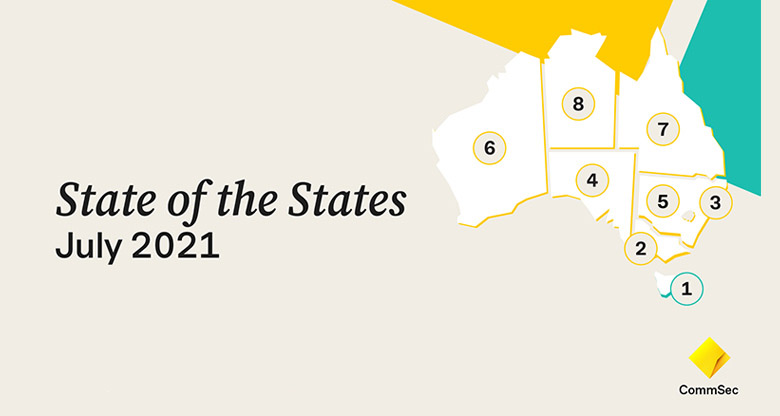Each quarter, CommSec looks at eight key indicators to determine how each state and territory is faring. The current value for each indicator is compared with the decade average, or “normal” level of activity. The eight indicators are:
- Economic growth
- Retail spending
- Equipment investment
- Unemployment
- Construction work done
- Population growth
- Housing finance
- Dwelling commencements
Here’s how the July 2021 quarter turned out
All state and territories have been well supported by highly stimulative fiscal and monetary policies, says CommSec Chief Economist Craig James. Economic activity is solid, especially in construction, while job markets continue to improve.
In relative performance, Tasmania has consolidated its top position well ahead of other economies for the sixth consecutive quarter.
- The success in supressing the Covid-19 virus has meant Tasmania hasn’t been forced to lock down its economy to the same extent as other states, although it has had to close borders.
- There are few signs of Tasmania giving up the position as top performing economy in the next six months.
- There is little to separate the other states and territories, although there remains a gap between seventh position and the Northern Territory economy.
- Tasmania is ranked first on relative population growth, equipment investment, relative unemployment and dwelling starts. It ranks second on retail trade and third on relative economic growth.
- Identifying a challenger to Tasmania’s top position isn’t easy. Queensland is well supported by internal migration that is driving retail spending, plus demand for houses and cars. Its jobless rate stands at a 12-year low.
- Looking ahead, Covid case numbers and vaccination rates, particularly the latter, hold the key to restoring a sense of “normality” and reducing both uncertainty and volatility.
So how did each state and territory fare?
- Tasmania
Strength: Retail trade
Weakness: Relative unemployment - Victoria
Strength: Construction work done
Weakness: Relative population growth - ACT
Strength: Retail trade
Weakness: Relative unemployment - South Australia
Strength: Dwelling starts
Weakness: Retail trade - New South Wales
Strength: Housing finance
Weakness: Relative population growth - Western Australia
Strength: Relative economic growth
Weakness: Construction work - Queensland
Strength: Relative population growth
Weakness: Equipment investment - Northern Territory
Strength: Relative population growth
Weakness: Equipment investment




